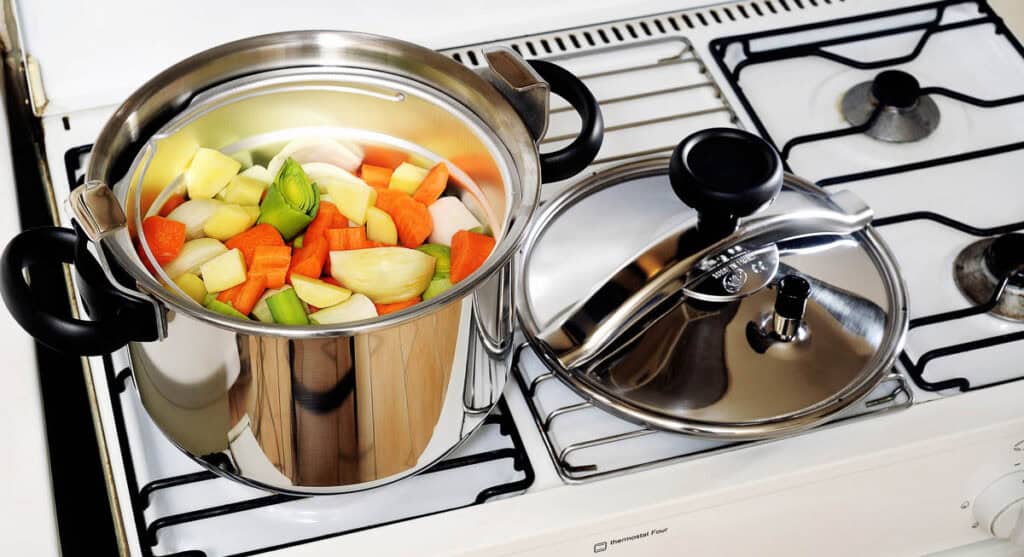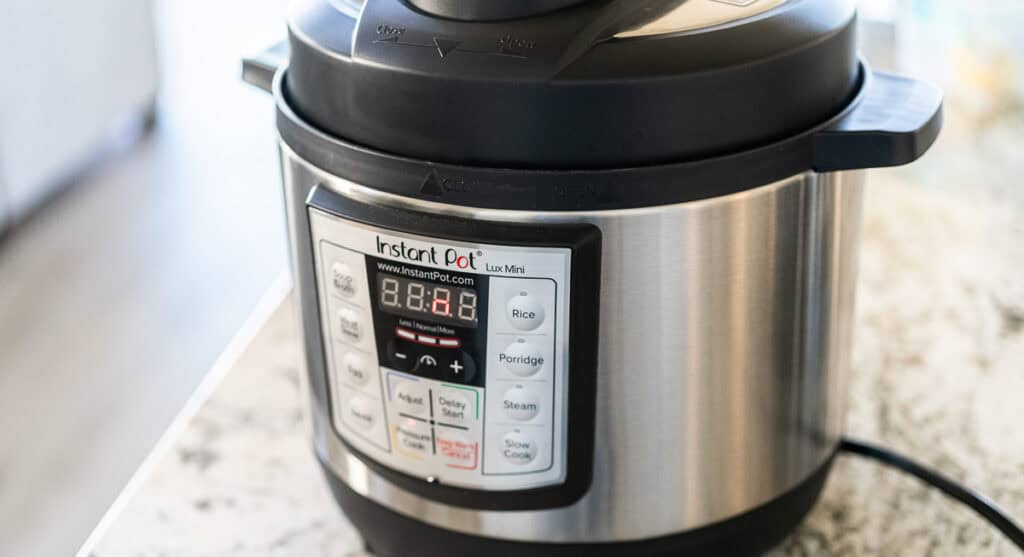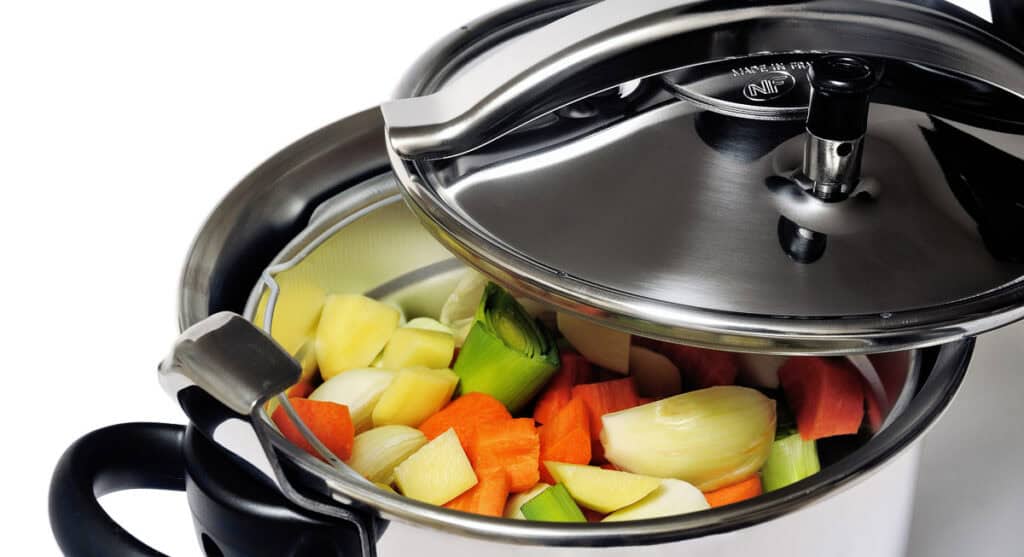Cooking with a pressure cooker has revolutionized home cooking, allowing you to make dishes that traditionally take hours in a fraction of the time. Your pressure cooker isn’t just for beans anymore. It’s a time-saving machine, turning traditionally slow-cooked dishes into quick and easy feasts.

Its ability to quickly tenderize ingredients while infusing flavor results in efficient, energy-saving cooking. As you familiarize yourself with pressure cooking, you’ll discover ways to make your busy weeknights easier.
What is a pressure cooker?
A pressure cooker is a sealed cooking pot that uses high pressure to cook food. The high pressure allows steam to build up and cook food quickly while preserving nutrients and flavors.
Pressure cookers were invented in the 17th century by French physicist Denis Papin. Over time, they have evolved from Papin’s early design to the safety-equipped electric and stovetop models you find in kitchens today.
This kitchen appliance gained some popularity after World War II, but safety concerns limited its use. Recent technology, which eliminates most of the safety issues, has brought it back into common use.
How pressure cookers work
Understanding the science behind pressure cookers will help you use them effectively. The pressure cooker creates an airtight seal with a locking lid, causing steam and pressure to build inside. As pressure increases:
- Boiling point increases: Normally, water boils at 212 F, but inside a pressure cooker, it can reach up to 250 F.
- Cooking time decreases: With the boiling point raised, food cooks faster — up to 70% quicker than traditional cooking methods.
- Flavors intensify: The steam infuses the food with flavors, while the high pressure helps tenderize tough cuts of meat.
Since a pressure cooker creates steam, cooking with one always requires liquid. By understanding these mechanics, you’ll be able to harness your pressure cooker’s full potential.

Types of pressure cookers
There are two types of pressure cookers: stovetop and electric. Both work on the same principle and are safe and effective.
Stovetop pressure cookers are durable, but you must manually adjust the heat using your stove burners. Electric pressure cookers, like the Instant Pot, provide their own heat and have multiple cooking functions.
Cooking with a pressure cooker
Learning how to cook with a pressure cooker is surprisingly easy and similar to using a slow cooker, just faster. With the proper techniques, tools and safety knowledge, you’ll be a pressure cooker expert, ready to make easy meals that don’t require hanging around the stove all night.
“I have always struggled to cook large cuts of meat well. But ever since I got my pressure cooker, cooking meat has become the simplest task. It always cooks it to perfection.”
— Zuzana Paar, Best Clean Eating
Cooking technique
Mastering a few key steps is all it takes to unlock the magic of pressure cooking. Here’s a simplified roadmap to delicious, perfectly cooked meals, all achieved with minimal effort on your part.
- Put the ingredients in the pressure cooker, along with the liquid.
- Make sure the silicone gasket on the lid is in place. Close the lid and close the pressure valve so the steam stays inside.
- Set the pressure cooker to the correct pressure. If you have a stovetop model, put the cooker on the stove and turn the heat on. For electric models, this involves selecting your cooking program.
- Wait for the cooker to reach pressure. Electric pressure cookers will do this automatically, following their programmed cycle. On a stovetop, you will need to adjust the heat to maintain the desired pressure level.
- Wait for the cooking specified by the recipe.
- Release the pressure once the food is cooked.
This is primarily a hand-off, set-it-and-forget-it process. You have plenty of time to do other things while the pressure cooker works.
“My favorite Instant Pot hack is using it to cook frozen chicken — no thawing beforehand necessary! Just place your frozen chicken breasts and 1 cup of broth or water in the Instant Pot, set to high pressure for 10 minutes, and enjoy!”
— Anne Mauney, MPH, RD, fANNEtastic food

Natural vs. quick pressure release
The type of pressure release you use is a critical factor in pressure cooker recipes. Understanding the difference between natural and quick release helps you choose the best recipe method.
- Natural release: Remove the heat so that pressure gradually drops. This will happen automatically in an electric pressure cooker. This is the preferred technique for many meats and foods that foam during cooking and can take 10 to 30 minutes.
- Quick release: Manually release the pressure by opening the cooker’s valve. This is best for vegetables and quick-cooking items, as it helps avoid overcooking.
Safety tips when cooking with a pressure cooker
While pressure cookers are fantastic for cooking quick and flavorful meals, you still need to follow a few common-sense precautions. Modern models have built-in safeguards like locking lids and pressure indicators, but there are a few things to watch for a worry-free cooking experience.
- Inspect the seals: Regularly check the silicone gasket for wear.
- Don’t overfill: Always fill only two-thirds or half full for foods that expand.
- Release the pressure safely: Follow the recommended method for releasing pressure after cooking. Never try to open the lid while the pressure cooker is still pressurized.
Popular pressure cooker recipes
Pressure cookers are fantastic tools for making quick and delicious meals. Here are some popular recipes that they excel at.
Stews: Your pressure cooker can turn beef or chicken into a hearty stew in just about an hour.
Tough cuts of meat: A pressure cooker turns inexpensive, tougher cuts of meat into melt-in-your-mouth masterpieces.
Rice: Pressure cookers turn fluffy, perfectly cooked rice from a side dish into a stress-free staple.
Cheesecake: Using a pressure cooker’s steam to bake cheesecake results in a smooth and evenly cooked filling that rivals oven-baked versions.
Soup: There is no need to simmer all day. A pressure cooker creates rich soup in a fraction of the time.
Curries: Pressure cooking locks in the vibrant flavors of spices and aromatics in curries, creating a depth of flavor.
“I didn’t love using my Instant Pot until I started making rice in it. Rice comes out perfectly every single time. From there, I went to other recipes and even combined rice, meat and veggies. It really is a quick and easy way to cook with minimal cleanup!”
— Gena Lazcano, GingerCasa.com

Summing up
Cooking with a pressure cooker allows you to whip up hearty dinners, tenderize tough cuts of meat and even bake desserts in a fraction of the traditional time. By understanding how pressure cookers work, you can unlock a world of possibilities that save you time and enhance the taste and nutritional value of your meals.
Anne Jolly is the creator of the food blog Upstate Ramblings. She loves to cook with gadgets like an air fryer, sous vide or pressure cooker.